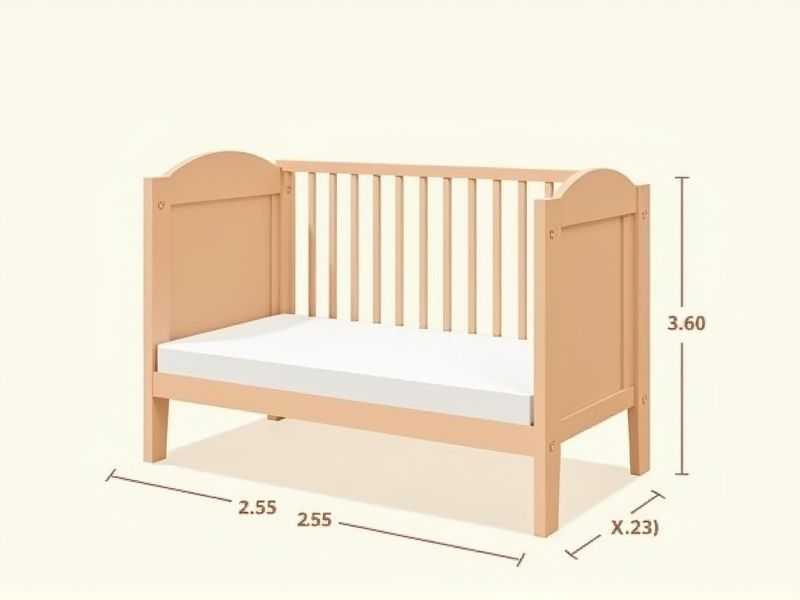
When choosing a crib, understanding the standard dimensions can help ensure a safe and comfortable fit for your baby and mattress. In the United States, standard full-size cribs typically measure about 28 inches wide by 52 3/8 inches long (71 cm x 133 cm) on the inside, which means most crib mattresses are designed to fit these dimensions snugly for safety reasons. It's important to check that your crib mattress fits tightly with no gaps larger than two fingers between the mattress and the crib frame. By choosing a crib with these standard dimensions, you ensure compatibility with most sheets, mattresses, and accessories readily available in stores.
Length: 52 Inches
A standard crib measures 52 inches in length, ensuring a safe and comfortable sleeping space for your baby. This size accommodates most crib mattresses, which typically range from 27 to 28 inches in width. With a standard crib, you can expect features like adjustable mattress heights, enhancing accessibility while keeping safety as a priority. Your investment in a quality crib can significantly support your child's development during those crucial early months.
Width: 28 Inches
The standard width for a crib is typically 28 inches, ensuring safety and stability for your baby during sleep. This measurement complies with safety regulations set by organizations like the Consumer Product Safety Commission (CPSC), which aims to reduce the risk of accidents. With a width of 28 inches, cribs can fit securely in various nursery layouts while providing ample space for your child. Always confirm that the crib meets the latest safety standards to give you peace of mind as your baby grows.
Height: Around 36 Inches
A standard crib height typically measures around 36 inches from the ground to the top of the mattress support. This height is designed to ensure safety and ease of access for parents while minimizing the risk of falls. Many cribs also offer adjustable mattress heights, allowing you to lower it as your child grows. Ensuring the crib meets these standards is essential for creating a secure sleeping environment for your baby.
Mattress Thickness: Up To 6 Inches
When selecting a crib mattress, it is essential to adhere to the recommended thickness of up to 6 inches for safety and comfort. This specific measurement helps ensure a snug fit within the crib frame, reducing the risk of suffocation or entrapment. Choosing a mattress within this standard enhances overall support for your baby's developing body, promoting better sleep. Consider high-quality materials that provide breathability, as proper airflow is crucial for maintaining a safe sleeping environment.
Space Between Slats: No More Than 2.375 Inches
The standard for crib safety emphasizes that the space between slats must not exceed 2.375 inches, ensuring infants cannot slip through or become entrapped. This measurement is crucial for preventing suffocation and other injuries associated with poorly designed cribs. Always check your crib specifications, as older models may not meet the latest regulations, putting your baby at risk. Prioritizing this safety guideline enhances your peace of mind while providing a secure sleeping environment for your child.
Adjustable Mattress Support Heights
An adjustable mattress support height in a crib typically offers three to four settings, allowing you to customize the mattress height as your baby grows. This feature enhances safety by ensuring that the mattress can be lowered as your infant learns to stand, reducing the risk of falls. Cribs with adjustable heights are designed to accommodate standard mattress sizes, such as 52 inches by 28 inches, ensuring compatibility and safety. Investing in a crib with this adjustable feature can aid in ease of access for parents during those early months while promoting a secure sleeping environment for your child.
Non-Drop Side Rails
When selecting a crib, prioritize models with non-drop side rails for enhanced safety and stability. These designs eliminate the risk of gaps that may occur in traditional drop-side cribs, significantly reducing the potential for accidents. In 2022, the Consumer Product Safety Commission (CPSC) imposed strict regulations, ensuring that cribs manufactured after 2011 are equipped with non-drop side rails. You can find a variety of stylish and functional non-drop side cribs, making it easier to create a safe and attractive nursery for your child.
Lead-Free Paint And Finish
When selecting a crib, prioritize options that utilize lead-free paint and finishes to ensure a safe environment for your baby. Lead exposure can lead to serious health issues, including developmental delays and cognitive impairments. Many manufacturers now adhere to strict safety standards, providing cribs that meet regulatory guidelines for non-toxic materials. Always verify certifications and product specifications to ensure your child's sleeping space remains free from harmful substances.
Fixed Side Rails
Fixed side rails are a crucial safety feature in crib design, providing stability and preventing accidental falls. These rails, typically made from sturdy materials like wood or metal, are installed at a height that ensures your infant remains securely within the crib's boundaries. Industry standards recommend that the distance between the slats should not exceed 2 3/8 inches to reduce the risk of entrapment. Regularly checking the integrity of fixed side rails is essential, as wear and tear can compromise their effectiveness over time.
Compliance With Safety Standards
The standard for cribs emphasizes strict compliance with safety regulations, ensuring a secure sleeping environment for infants. Cribs must meet guidelines set by organizations like the Consumer Product Safety Commission (CPSC), which mandates features such as slat spacing no wider than 2 3/8 inches to prevent entrapment. Regular safety testing evaluates components like mattress support, non-toxic finishes, and sturdy construction, which collectively contribute to reducing risks. As a caregiver, verifying that your crib complies with these established standards is crucial for your child's wellbeing.
